
Several weeks ago we talk here on the blog about the composer Sway, which is designed for Wayland and a drop-in, which is intended to be a replacement for the i3 window manager for X11. It works with your existing i3 setup and supports most i3 features, plus some extras.
Now after several weeks developmental the release of the new version of Sway 1.2 was announced, which is built using the Wayland protocol and it is fully compatible with i3 window manager and i3bar panel.
About Sway
Sway i3 support is provided at the command level, configuration files, and IPC, allowing you to use Sway as a transparent replacement for i3, using Wayland instead of X11.
Sway allows you to place windows on the screen not spatially, but logically.
The windows are arranged to form a grid that optimally uses screen space and allows you to quickly manipulate the windows with just the keyboard.
The following components are provided to organize a complete user environment: swayidle (background process with implementation of the KDE idle protocol), swaylock (screen saver), mako (notification manager), shady (take screenshots), sip (highlight an area on the screen), wf-recorder (video capture), waybar (application panel), virtboard (on-screen keyboard), wl-clipboard (working with clipboard), wallutils (desktop wallpaper management).
Sway it is being developed as a modular project built on top of the library wlroots , which contains all the basic primitives for organizing the work of the composite manager.
Wlroots includes backends to abstract access to the screen, input devices, render without directly accessing OpenGL, interact with KMS / DRM, libinput, Wayland y X11 (A layer is provided to launch Xwayland-based X11 applications.)
Besides Sway, the library wlroots it is also actively used in other projects, including Librem5 and Cage.
In addition to C, C ++, folders have been developed to Scheme, Common Lisp, Go, Haskell, OCaml, Python y Rust. The project code is written in C and distributed under the MIT license. The project is designed for use on Linux and FreeBSD.
Main new features of Sway 1.2
In this installment of the composer Sway 1.2 developers worked to improve compatibility with i3 window manager 4.17, thereby ensuring greater compatibility of both projects and they can work together.
Another improvement that stand out in the ad it is in the mechanism to change the keyboard layout, because in this new version, support has been added to determine the types of input devices and a new command has been proposed xkb_switch_layout.
As well support for cursor themes was added, for which a new command xcursor_theme was proposed, as well as support for pop-up windows in the shell.
On the other hand, the new support implemented for the protocol stands out in Sway 1.2 Wayland wlr-output-management-v1 which is designed to configure output devices.
Last but not least, The option to start an application after restarting was also added.
Of the other changes mentioned in the announcement of this new version:
- Added a switch to select the default method to split windows into tabs or side by side (like a stack)
Added support for atomic display settings via theAPI wlr_output
Added calibration matrix settings for touch screen calibration
Fixed various memory leaks and issues leading to crashes.
How to get Sway 1.2?
For those interested in being able to test Sway on their systems, dThey should bear in mind that the main requirement to be able to use it is to have Wayland under the hood of your system.
To install Sway on your distro, You should visit the following link where you will find the project files as well as the instructions for its installation.
It is important to mention that Sway will not work with proprietary graphics drivers, you will have to uninstall these and use the free drivers instead.